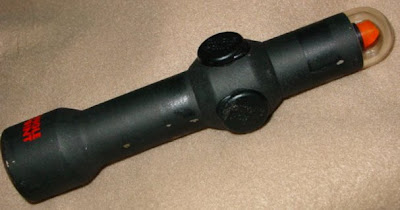The "nudge" trigger release
In almost every case, the "surprise break" trigger stroke is the best way to fire an accurate shot. This is the standard method taught to generations of hunters, target shooters and soldiers: Apply pressure on the trigger progressively until, at a moment not of your choosing, the gun fires. You don't make it fire, you let it fire, as if by itself. As I explain elsewhere, if you do not know the exact instant the shot will fire, you will not know when to respond to the shot being fired. In other words, you will not know when to flinch. So you won't; the gun stays on target as the shot is triggered. That is the purpose, and whole point, of the surprise break trigger stroke.
There is another way to manage the trigger. The goal is the same, to make the gun fire at a moment not selected consciously, but the thing is gone about differently. This other technique is sometimes called the nudge, and sometimes called the bump. I will call it the nudge, to avoid confusion with bump firing, a fast way to convert money into noise.
To nudge off a shot: You begin by watching your sight wobble on the target. At a moment when the sight is perfectly aligned, you quickly apply pressure to the trigger--but not enough to fire the shot. Hold that degree of pressure as the sight wobbles off target again. The next time the sights are perfect you quickly add a little more pressure. Continue in that manner until you have added enough pressure to release the shot. So your trigger stroke is nudge. . .nudge. . .nudge. . .nudge. . . You don't know exactly how many nudges it will take to build up enough pressure to fire the gun, but each time you up the pressure, you have in mind that the gun will not fire this time, and therefore you do not flinch when you press on the trigger. On one of the nudges, though, the trigger releases and off she goes!
The theory goes like this, since you are only increasing the pressure when the sight is exactly on target, you cannot fire at any time the sight is not dead on. So by simple logic, you can only fire when the sight is right on target.
It's a pretty good theory. The matter reminds me, though, of the old engineering maxim: In theory, theory and practice are the same, but in practice they are different. The trouble with the nudge is it relies on observing when the sights are just right and responding immediately, but since your eye-hand coordination is always imperfect, you don't get as much precision out of this nudge-nudge-nudge rigmarole as you might expect.
The best use of this technique is in persuading the fellow who flinches that he is being silly. If he pulls on the trigger and the sight slews way off target, he can see immediately what he is doing. By learning to press the trigger with the assumption that nothing will happen, he can overcome the natural tendency to react to tons of pressure being generated and released under his nose.
There are a few cases when the nudge is useful afield. When good sight alignment on target is fleeting, think of the nudge. You up the pressure when you are on target and suspend pulling the trigger when your sight drifts off The Marine Corps manual explains the matter this way:
Uninterrupted Trigger ControlThe preferred method of trigger control in a combat environment is uninterrupted trigger control. After obtaining sight picture, the Marine applies smooth, continuous pressure rearward on the trigger until the shot is fired.Interrupted Trigger ControlInterrupted trigger control is used at any time the sight alignment is interrupted or the target is temporarily obscured. An example of this is extremely windy conditions when the weapon will not settle, forcing the Marine to pause until the sights return to his aiming point. To perform interrupted trigger control:
- Move the trigger to the rear until an error is detected in the aiming process.
- When this occurs, stop the rearward motion on the trigger, but maintain the pressure on the trigger, until sight picture is achieved.
- When the sight picture settles, continue the rearward motion on the trigger until the shot is fired.
You can learn almost everything about this technique by dry firing while giving careful attention to the sight picture. You should, of course, master it using live fire on the target range before taking it to the field. Some people shoot very well with this technique; others find it a waste of time. To find out which group you are in, you must try it for yourself.


Comments
Post a Comment